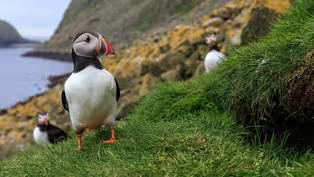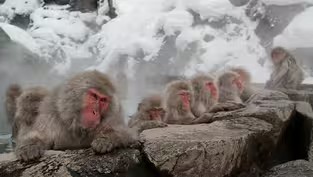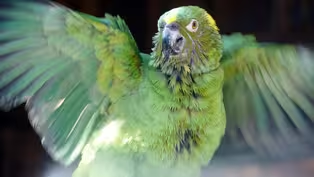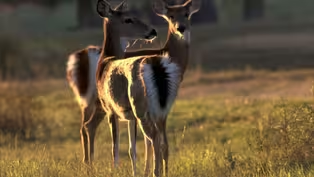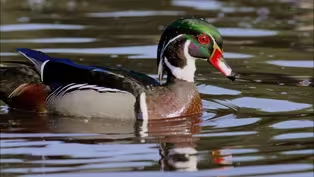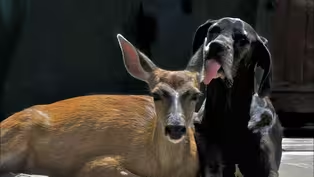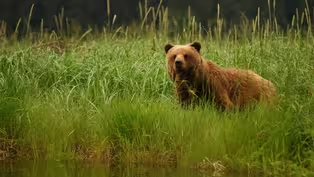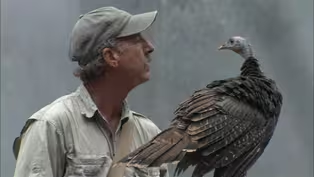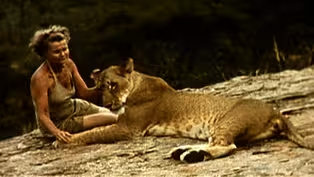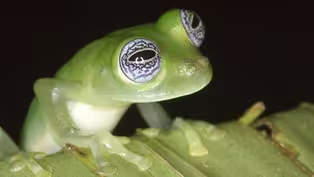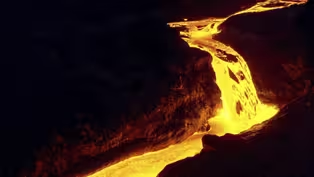
Bonebreakers' Mountain
Season 8 Episode 1 | 56m 46sVideo has Closed Captions
Spanish Pyrenees, cranes, fox and marmot
A bearded vulture, the bonebreaker, feeds atop the harsh Pyrenees separating Spain and France.
Problems playing video? | Closed Captioning Feedback
Problems playing video? | Closed Captioning Feedback
Major support for NATURE is provided by The Arnhold Family in memory of Henry and Clarisse Arnhold, Sue and Edgar Wachenheim III, The Fairweather Foundation, Charles Rosenblum, Kathy Chiao and...

Bonebreakers' Mountain
Season 8 Episode 1 | 56m 46sVideo has Closed Captions
A bearded vulture, the bonebreaker, feeds atop the harsh Pyrenees separating Spain and France.
Problems playing video? | Closed Captioning Feedback
How to Watch Nature
Nature is available to stream on pbs.org and the free PBS App, available on iPhone, Apple TV, Android TV, Android smartphones, Amazon Fire TV, Amazon Fire Tablet, Roku, Samsung Smart TV, and Vizio.
Buy Now
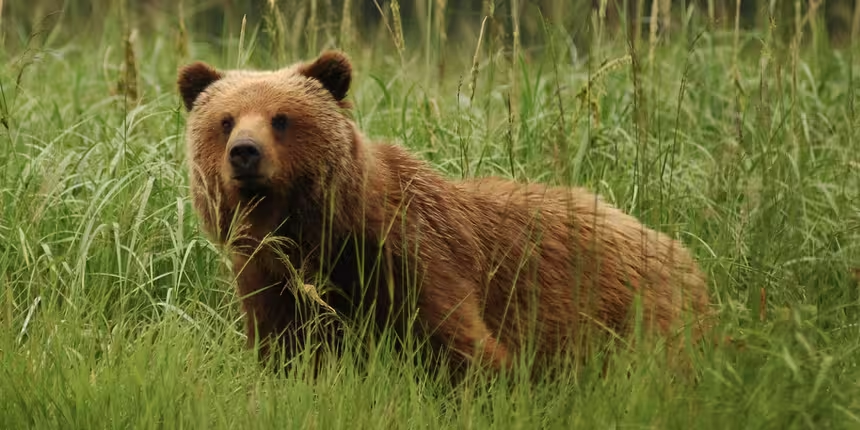
Explore More Ways to Watch
Bring the beauty and wonders of wildlife and natural history into your home with classic NATURE episodes.Providing Support for PBS.org
Learn Moreabout PBS online sponsorshipMore from This Collection
Watch classic NATURE episodes with the PBS station member benefit Passport.
Video has Closed Captions
Animals congregate in huge colonies partly out of necessity and partly for the security. (52m 55s)
Video has Closed Captions
Follow a troop of snow monkeys in Japan to see how they prepare to face the world. (52m 58s)
Video has Closed Captions
Parrots and the bittersweet world they share with humans. (53m 10s)
Video has Closed Captions
Learning about one of our closest neighbors: the white-tailed deer. (53m 10s)
Video has Closed Captions
Take a fascinating look at one of our most familiar birds. (1h 42s)
Video has Closed Captions
Love apparently knows no boundaries in the animal kingdom. (53m 20s)
Video has Closed Captions
Enter a world shaped by bears, trees, and salmon. (50m 9s)
Video has Closed Captions
One man's remarkable experience of raising a group of wild turkey hatchlings to adulthood. (58m 51s)
Elsa's Legacy: The Born Free Story
Video has Closed Captions
The true story that inspired "Born Free". (53m 10s)
Video has Closed Captions
It is the greatest mass extinction since the dinosaurs. (53m 43s)
Video has Closed Captions
Kilauea, on Hawaii's Big Island, is the world's most active volcano. (54m 6s)
Video has Closed Captions
Relationships with cats and dogs are some of the longest and most intimate of our lives. (53m 30s)
Providing Support for PBS.org
Learn Moreabout PBS online sponsorship[melodic music] [trumpet music] - This is Saint Jean, a charming medieval village in the foothills of the Spanish Pyrenees.
Hi, I'm George Page For Nature.
It's the local people from little towns like this, the Catalans, the Aragonese, and the Basques, who risked their lives during World War II helping downed airmen and French resistance fighters escape to freedom over these mountains.
Extending 270 miles from the Bay of Biscay to the Mediterranean, the Pyrenees cover 27,000 square miles, reach up to more than 11,000 feet, and of course, form the border between Spain and France.
Over the years, we've circled the globe for the Nature series, but we've rarely been to Western Europe and the reason is simple.
There's not much of nature left in this part of the world.
Long ago, man cleared its ancient forest to make room for industry, agriculture, and the great European cities.
But here in the Spanish Pyrenees, we find an exception.
The high peaks of these mountains remain a remote wilderness, a refuge for wildlife, and one of the few places in Europe where we can actually make a natural history film.
Survival, however, in these mountains, can be terribly hard especially in winter.
[wind blowing] High mountains like the high Arctic, are bitterly cold, swept by storm, buried in snow for most of the year.
It's surprising any animals could find a foothold here.
[wind blowing] But these places have become a sanctuary for many animals unable to coexist with man in the foothills below though even this refuge is not completely safe, danger waits on these steep slopes.
[falling avalanche of snow] Death is no stranger to these mountain gorges.
Vultures soon gather around the animals swept away by avalanches.
Among the carrion eaters is a bird that stands out from all the rest.
It's plumage is very different and it seems to be interested not only in the meat, but in the bare bones as well.
Combining traits of both an eagle and a vulture, the lammergeier has developed a unique advantage among birds.
When the precious meat is gone, it devours the bones others leave behind, taking them up 500 feet and dropping them to smash into small pieces on the rocks below.
It's known in these mountains as the bonebreaker and it's one of many remarkable animals that share this high mountain world.
[Spanish music] 10,000 feet above sea level stand the savage summits that run like watch towers along the spine of Europe's wildest frontier, the Spanish Pyrenees.
The Pyrenees are an ancient complex mountain range but still growing, created over millions of years by relentless movements of the Earth's crust.
During the ice ages, glaciers gnawed at the mountains leading the remains of younger rocks balanced on the tops of the older crystalline cores.
The work of the glaciers is everywhere.
Sharp peaks, immense cliffs, hanging valleys, deep canyons gouged from the living rock, but despite the ravages of ice, the mountains still run in an unbroken wall from the Bay of Biscay to the Mediterranean, a distance of some 240 miles.
The Moors call them El Hadjiz, the barricade, the great divide between France and Spain.
Overall, the Pyrenees cover about 22,000 square miles of which two-thirds fall on the Spanish side where our story is set.
Looking at this unsparing wilderness, it's hard to imagine that it might be home to a very diverse range of animals.
Without special equipment, a human would certainly perish here, so how do wild creatures find enough to eat?
Where do they shelter and how do they raise their young in this harshest but least spoiled, of Europe's high places.
Mountains are attractive when the weather's good but the Pyrenean winters are hostile.
An animal killed by the cold or an avalanche is a windfall that must be eaten as soon as possible.
There's fierce competition for any food, whatever the conditions.
The ravens are chased off the carcass by the fox but they'll still grab what they can.
[wind blowing] Foxes are found throughout Europe but the Pyrenean fox tends to be larger with a thicker coat to protect him against the severe mountain winds.
[wind blowing] Snow has benefits as well as drawbacks.
It's a good insulator against the wind and some of the mountain animals make good use of it.
In early April, marmots emerge from hibernation.
It's the marmots first foray from their burrows since the weather drove them underground last autumn.
There's a whole new landscape to explore.
[birds screeching] After a winter spent curled up asleep, the marmots need water.
Dehydration is one of the side effects of hibernation, so often they eat snow.
With the sun's increasing warmth, they can feel spring in the air but milder weather triggers great danger.
[wind blowing] [avalanche of snow falling] The avalanche is over.
The marmots are soon investigating the new fall of snow.
They're inquisitive and social and one of the first things they establish at this time of year is a hierarchy.
The males wrestle to establish who shall be dominant.
[marmots chirping] [snow crunching] Besides the marmot, there's another animal that relies on a blanket of snow to survive.
As the snow melts, its excavations come to light.
It spends the winter in snow tunnels.
It's called the snow vole, and while the snow lasts it burrows under it looking for bulbs.
Bulbs are especially nutritious.
Last year's goodness has stored for this year's flowering if it isn't nipped in the bud first, Snow voles don't often venture out above the snow where hill foxes or birds of prey may see them.
When the snow goes in a month or so, they'll tunnel into the soil like a mole.
In April, the alpine choughes form great soaring flocks.
There are two kinds of choughs here, the common chough which lives on ragged cliffs, and the alpine chough with a yellow bill which lives higher up near the snow line.
Both species belong to the crow family.
These alpine choughs are looking for insects on rocks exposed by melting snow.
They feed energetically as they prepare for the short breeding season ahead.
[birds chirping] [wind blowing] They live among the lofty peaks isolated from the rest of the world, but for many mountain animals, that isolation is beginning to crumble.
Man, the skier, threatens parts of the Pyrenees.
It's not the skiing itself, it's all the things that go with it.
New resorts reach ever higher into the mountains.
Lonely valleys are broken into and emptied of their ancient silence, but life is so fragile in the mountains that even a hiking boot can kill a plant like the purple saxifrage.
The combination of erosion and disturbance can drive out the wildlife.
Until now, the Pyrenees have not felt the hand of man to the same extent as the Alps.
There, birds like the bonebreaker were driven out long ago.
One species that keeps well away from man is the chamois.
It's been seen near the summit of the highest peaks in the Pyrenees.
It would live lower down, but freedom from disturbance outweighs the better grazing below.
Many calves are born as early as March, of every ten, seven will die.
They succumb to the cold, they fall to their deaths or get swept away in avalanches.
[wind blowing] The thaw has begun and the mountains echo to the torrents of spring.
[water running] With a break in the weather, flocks of European cranes cross the mountains on their way from Spain to Scandinavia.
They're one wave of a larger migration of hundreds of thousands of cranes.
Crossing the Pyrenees can only be attempted in good weather.
[birds chirping] The cranes wings catch the light reflected by the snow as they drift over the high passes.
They'll only just make it before the weather closes in again.
Warm breezes blown in from the Atlantic mix with the cooler mountain air to bring a sudden return to winter.
[wind blowing] Trumpet gentians shut tight against the storm.
For the moment, Spring retreats under the ice.
In the snow fed mountain streams, there's a rare and prehistoric looking species found only in these cold waters of the Pyrenees, the Pyrenean brook salamander.
Its local name is the fountain keeper and it lives at altitudes of up to 10,000 feet in water near freezing, and even under the ice.
The brook salamander feeds on small crustaceans, tadpoles, insect larvae and worms washed out when the streams are running high.
They feed furiously as spring advances, there's no time to waste before the cold comes again and there's an equal urgency to breed in the all too brief summer season.
[water gurgling] It's not uncommon to find two or more males wound around the same female, each determined to mate with her.
The female is the one underneath.
[water gurgling] The salamanders are not the only amphibians adapted to life near the snow line.
When the marsh marigolds flower, frogs emerge from their winter sleep to breed.
For the tadpole, it will be a race against time to mature into adult frogs.
May is here, the snow is going and the marmots are moving up the hillsides away from their winter quarters.
For centuries, they were absent from the Pyrenees, but since being reintroduced from the Alps 40 years ago, they're now very much at home.
The marmots move among boulders casually thrown down by a glacier thousands of years ago.
There are signs of the abrasive action of glaciers everywhere in the Pyrenees.
This peak was formed when two glaciers on either side of the ridge cut back towards one another leaving a knife edge hanging in the clouds.
Such peaks can disgorge boulders at unpredictable moments.
In low clouds and mist, even the most experienced mountain hikers tread warily on the slopes below this peak but the mountain animals appear unperturbed.
A male chamois rubs his face against the bushes to leave his scent, marking the area as his territory.
In order to fatten up for the strenuous fall rut, large males reserve pockets of rich forage in summer.
If he has to dodge the occasional falling boulder, that's the price he pays for dining in solitude.
If the chamois survive their first year, they become extremely adept at moving along the dizziest ledges.
They have to, with every step, life literally hangs in the balance.
[birds chirping] In the old days, chamois were haunted here.
Now this has been stopped and these goat antelopes have done extremely well.
But this cannot be said of the Spanish ibex, a true goat, which has been almost hunted out of existence in the Pyrenees.
Today, the best place to see the Spanish ibex is here, in the Gredos mountains farther south.
Although these belong to a different subspecies than those in the Pyrenees.
The males are stocky animals twice the weight of the chamois, but no less surefooted.
[hoofs clicking on rocks] Ibex have a legendary ability to cling onto near vertical rock and the secret is in their hooves.
The two sides of the cloven hoof can move independently giving them a good grip on the rock.
The point of the hoof is hard, but the rest is elastic.
In addition, the dew claw above the hoof, can be used on exceptionally steep faces for even greater traction.
The males develop dark coats when they're about nine years old.
Like all goats, ibex seem to be able to eat almost anything.
They can even scrape a living off the rocks by eating the lichens growing on them.
It was to save the Spanish ibex that the Ordesa National Park was created in 1918.
Ordesa is Spain's answer to the Grand Canyon.
Many say it's the most beautiful park in Europe, an ice age valley carved in limestone.
At high altitudes, the radiation from the sun is intense.
By June, the canyon would be a desert if it weren't for the glaciers farther up in the mountains and this is where the bonebreaker searches for bones.
[wind blowing] There are about 70 small glaciers in the Pyrenees, each a constant source of water, ice and avalanches.
And wherever there are avalanches, the bonebreaker is likely to be found.
This bird regularly patrols the ice face.
It can scour miles and miles of country for a meal, soaring on wings spanning nine feet.
The glaciers are relics of an ice age, which once buried these mountains, centuries of snowfalls laid to rest in deep frozen layers.
Depending on the amount of snowfall, the glacier may advance or retreat a few feet each year.
The ice at the front face may have fallen as snow when Columbus set sail for America, but eventually it gives way.
[snow rushing down] With the ice, melt water pours down the mountains, allowing life to flourish below.
In shallow pools warmed by the sun, amphibians can breathe.
The tadpoles problem at these altitudes is finding anything to eat.
Many resort to a macabre form of cannibalism.
They're feeding on frogs that didn't make it through the winter.
The tadpoles have to compete with a multitude of blood worms that hatch out at the same time.
In the lean mountain economy, nothing goes to waste.
[water gurgling] Farther down the mountain lives the Pyrenees most bizarre aquatic animal.
Found in larger streams and rivers, it always looks soggy and bedraggled out of water.
But underwater this animal takes on a very different look.
It's called the Pyrenean desman.
The desman is an animal in a group of its own though it's distantly related to the mole.
It feeds on crustaceans and fish which it often stores for later consumption.
Like the mole, the desman has very poor eyesight.
It follows its prehensile horn shaped nose while searching out prey.
In fact, it's also known as the rat with the trumpet nose.
Outside Spain and France, desmans are found only in a tiny region of Caspian Russia and where they do occur, there are never very many, perhaps because mountain streams don't contain much food.
Here in the Pyrenees, endangered by dams and water pollution from soil erosion and ski resorts, they may be nearing extinction.
On the southern side of the Spanish Pyrenees is a smaller range of mountains called the Pre-Pyrenees.
Honey colored sandstone replaces the gray granite and limestone of the central range.
Both the Pyrenees and these lower peaks are the breeding site of one of the rarest birds in Europe, the bonebreaker.
The bonebreaker is a lammergeier, also known as the bearded vulture.
Now it's confined to a few mountain strongholds.
It flies more with the mastery of an eagle than the lazy soaring of a vulture.
Although perfectly capable of hunting, it's more of a scavenger and among the things it scavenges most successfully are bones.
The lammergeier drops its bone from up to 500 feet above the rocks, partly so that they smash into pieces small enough to eat, partly to get at the marrow, which it extracts with its hard tongue.
A good part of its diet is bone and gristle.
It wouldn't seem to be very nutritious but it appears to suit the bird very well.
Altogether.
only 30 or 40 pairs breed in the Spanish Pyrenees.
[birds chirping] The lammergeier even feeds bone and bone marrow to its chick.
Last year's offspring is still in the vicinity begging the other parent for food or perhaps it's just looking for company.
It still has dark plumage.
The adult plumage only develops in the fourth or fifth year but the parent will drive it away.
Lammergeiers do not tolerate any other bird of prey in their nesting territory, including their own grownup offspring.
The pair raises just one chick.
This youngster represents the whole year's parental investment.
There is variation in its diet.
The chick gets some meat attached to the bones.
Griffin vultures are unwanted intruders.
They compete for nest sites.
Lammergeiers are much faster in the air than vultures.
[birds chirping] The lammergeier is one of the hardiest of mountain birds, laying its eggs in snowy February.
Now, in summer, the parents return to feed the chick every two or three hours, and this requires an endless supply of carrion and broken bones.
[birds chirping] They break their bones on the same rocks year after year.
Sometimes they lose pieces, but precious little escapes their eyes.
These mysterious birds are the only ones in the world to break bones by dropping them from a great height.
They can also be found in Africa and Asia.
The European population has been under threat for decades.
When wolves lived in the Pyrenees, poisoned carcasses were put out to kill them, and many lammergeiers also died.
But the wolf was exterminated here in the Pyrenees a hundred years ago and poisoned baits are no longer used.
It's one of the very few places in Europe where the bone breaking lammergeier has been able to hold its own.
It would be wrong to suggest that this bird feeds only on bones.
It will take all sorts of carrion from dead rabbits to squirrels, even pine martins.
One was seen to bring nine pigeons to its chick in a single day.
The pigeons had been caught in a blizzard while crossing the mountains and the lammergeier had found them frozen in the snow.
But most of its diet is not wild animals, it's domestic stock.
Herds brought by man to these mountains have replaced wild animals as the lammergeiers main food source.
[water rushing] In mid-May, the farmers and shepherds take their stock into the mountains.
By July, the animals are in the high meadows.
There's always natural death among livestock and this is one of the things that has kept lammergeiers and vultures alive in Spain.
Horses are still used as draft animals to bring in the crops and the hay.
Grazing keeps the pastures open, without it, trees and scrub encroach.
These pastures are used by wild animals too like chamois and marmots.
Below the mountain meadows, the climate is warm enough to grow a few basic crops and that brings in the pigeons.
And the pigeons bring in the fastest of falcons, the peregrine.
[birds chirping] The falcon entirely misjudges its scoop but it quickly recovers for a second attempt.
It strikes with its feet, trying to stun its prey in mid air.
[birds chirping] The falcon gains height and turns to pursue its quarry once more.
[dramatic music] Peregrine falcons have become less common in Europe since the introduction of intensive agriculture with it's poisonous pesticides.
Small scale mountain farming like this in the Asturias Mountains of northwest Spain is good for peregrines and for many other kinds of wildlife.
This simple farming is based on old, almost medieval traditions.
Man has a long history here.
In the limestone caves of northern Spain, we can get an impression of what life was like before man began to farm.
In those days, he was a hunter.
The last ice age had just ended and the climate was still cold.
People used these caves some 15,000 years ago.
On the walls they painted the animals they hunted, mammoths, wild horses and bison.
The mammoths are long gone and man has all but exterminated the bison and wild horse.
There are paintings of other animals too.
A bear and its cub.
Brown bears, the same species as our grizzlies, ranged throughout Europe in large numbers until several hundred years ago.
But man, the hunter, has diminished its numbers with poison, traps and guns.
Bears are dangerous predators and even though there are only a few left, they're still seen as a threat to man and his livestock.
This trap is capable of inflicting enormous damage to a bear.
Bears are seldom seen in Spain today.
Only a handful of people actually catch sight of one in the course of a year.
This family of three cubs and their mother is a rare find but it also testifies to the bear's plight.
The mother's right hind leg has been severed in a trap.
The surprising thing is that she's managed not only to recover from the wound and the trauma, but also to raise three cubs.
Quite exceptional, even for a European brown bear with four legs.
The five month old cubs have already learned to look under stones for beetles.
One of them dislodges a rock on the hillside and scares itself in the process.
Brown bear cubs are among the most appealing of all animals, but in Spain, it's sad to report that the species is probably within 10 or 20 years of extinction.
Though there are 20 on the French side, in the Spanish Pyrenees, there are just two bears left.
And in 1987, they had no young.
Here in the Asturias Mountains, there are around 90 bears.
However, despite legal protection from hunting since 1973, bears are still killed each year.
Occasionally bears move down to the villages to raid orchards and beehives and they're not shy about taking a foal or a goat.
Although there is financial compensation for this, bears do pose problems as they do all over the world.
For the brown bear in Spain, the mountains are their last retreat.
They make their final stand here or perish.
The Asturias Mountains also give us a glimpse of another predator once common in the Pyrenees.
It too has a habit of preying on domestic stock, including donkeys.
This wolf has been feeding her family, now she's returning for more.
Wolves are almost as rare as bears.
Wolves, of course don't pray only on domestic stock.
They hunt roe deer, mice, foxes, wild boar, and chamois.
But it's no use telling the hill farmer that, the wolf too has been forced into the high country, the only places it can avoid man and his traps.
There is perhaps one glimmer of hope for both the bear and the wolf.
In some parts of the mountains, man is retreating.
The villagers are disenchanted with a hard mountain life and are drifting away to the cities.
Some villages are now deserted in both the Asturias and the Pyrenees.
There just weren't enough people to keep them going.
But the exodus to the cities is not a good thing for all wildlife.
Abandoned pastures become overgrown with scrub and no longer provide grazing for chamois and marmots.
Also, dying village communities are often moved out wholesale so that valleys can be dammed for water and electricity.
Spain is thirsty for water and power, but it means the loss of the valleys and rivers that once supported animals like bears, wolves, and desmans.
The dams drive the animals farther and farther up the slopes until there's nowhere left to run.
With the first frosts of autumn, a new sound is heard in the mountains.
Ibex answer the challenge of the rut head on.
The large male ibex fight for the right to mate with the groups of females.
Once they're nine years old, males take on the distinguished black markings which indicate high status.
A male descends to take on an intruder.
[antlers hitting antlers] The color of coat is an indication of a male's breeding strength, not seniority.
An old male ibex past his fighting prime relaxes in the last autumn sunshine.
By early winter, all rivalries are forgotten.
The ibex are more concerned with finding sheltered valleys for the months ahead.
A vulture circles the canyons looking for the first casualties of the cold.
The raven is there first, but the corpse is frozen.
The raven will have to wait for the vultures to open it up.
[birds cawing] Even if the raven cannot get in as the vulture opens up the carcass, it certainly makes its presence felt.
[wings flapping] [birds chirping] All this feather pulling may look playful but it's not a game.
It's a battle which will decide how much each bird gets to eat and ultimately who survives in the winter and who starves.
Vultures are much more common in Africa than Europe but Africa isn't far from the Pyrenees.
There are several thousand griffin vultures here mainly on the Spanish side of the border.
That makes them one of the largest populations in Europe.
Elsewhere they've been poisoned, here, they're relatively safe.
The foxes have done well too.
All they have to contend with these days are natural hazards like vultures.
[birds shrieking] The fox will bury the meat in the snow for later.
For all the animals of the Pyrenees, life itself is a fight to the finish.
Few live here by choice.
Most have been driven to these mountains by man's encroachment.
[Spanish guitar music] These high places have become the last wild lands left in Europe, forbidding summits to hostile for man, they've become a harsh final refuge for animals.
[Spanish guitar music] [water rushing] [birds chirping] [water rushing]

- Science and Nature

Explore scientific discoveries on television's most acclaimed science documentary series.

- Science and Nature

Learn how centuries of knowledge helped our ancestors understand the mysteries of space.












Support for PBS provided by:
Major support for NATURE is provided by The Arnhold Family in memory of Henry and Clarisse Arnhold, Sue and Edgar Wachenheim III, The Fairweather Foundation, Charles Rosenblum, Kathy Chiao and...
